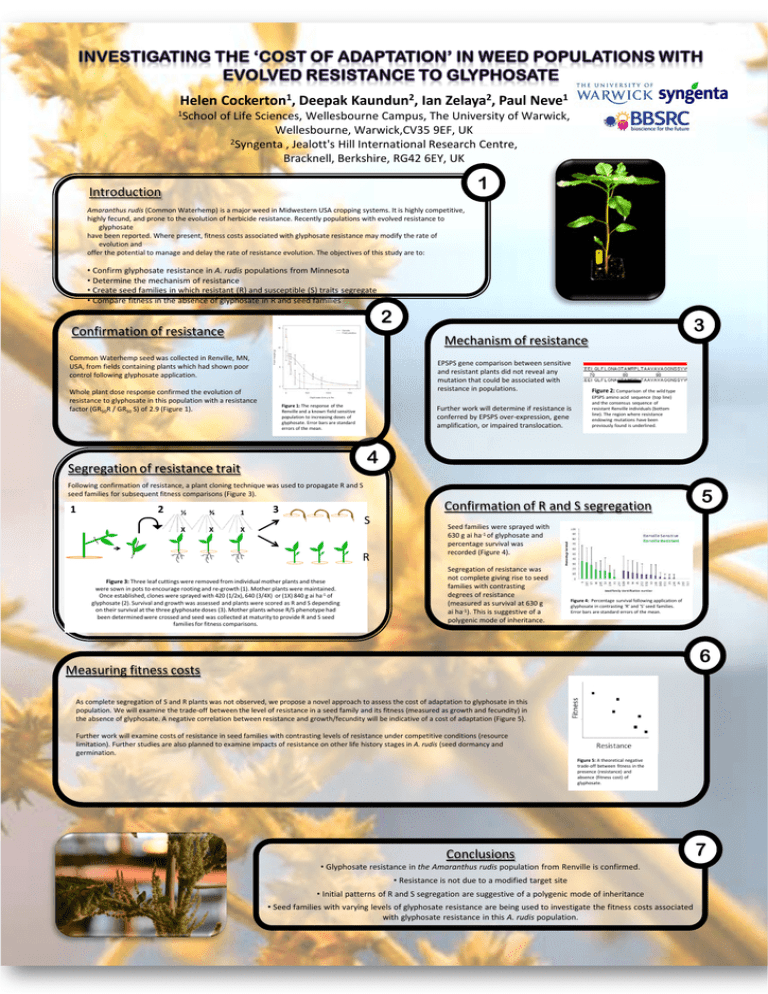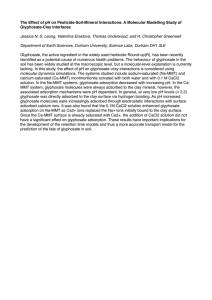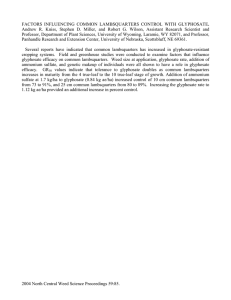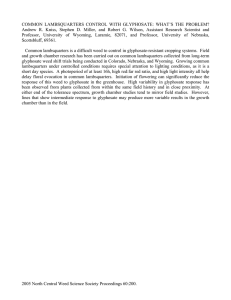Document 13202592
advertisement

Helen Cockerton1, Deepak Kaundun2, Ian Zelaya2, Paul Neve1 1School of Life Sciences, Wellesbourne Campus, The University of Warwick, Wellesbourne, Warwick,CV35 9EF, UK 2Syngenta , Jealott's Hill International Research Centre, Bracknell, Berkshire, RG42 6EY, UK 1 Introduction Amaranthus rudis (Common Waterhemp) is a major weed in Midwestern USA cropping systems. It is highly competitive, highly fecund, and prone to the evolution of herbicide resistance. Recently populations with evolved resistance to glyphosate have been reported. Where present, fitness costs associated with glyphosate resistance may modify the rate of evolution and offer the potential to manage and delay the rate of resistance evolution. The objectives of this study are to: • Confirm glyphosate resistance in A. rudis populations from Minnesota • Determine the mechanism of resistance • Create seed families in which resistant (R) and susceptible (S) traits segregate • Compare fitness in the absence of glyphosate in R and seed families 2 Confirmation of resistance Common Waterhemp seed was collected in Renville, MN, USA, from fields containing plants which had shown poor control following glyphosate application. EPSPS gene comparison between sensitive and resistant plants did not reveal any mutation that could be associated with resistance in populations. Whole plant dose response confirmed the evolution of resistance to glyphosate in this population with a resistance factor (GR50R / GR50 S) of 2.9 (Figure 1). Figure 1: The response of the Renville and a known field sensitive population to increasing doses of glyphosate. Error bars are standard errors of the mean. Further work will determine if resistance is conferred by EPSPS over-expression, gene amplification, or impaired translocation. Following confirmation of resistance, a plant cloning technique was used to propagate R and S seed families for subsequent fitness comparisons (Figure 3). 2 Figure 2: Comparison of the wild type EPSPS amino acid sequence (top line) and the consensus sequence of resistant Renville individuals (bottom line). The region where resistance endowing mutations have been previously found is underlined. 4 Segregation of resistance trait 1 3 Mechanism of resistance ½ ¾ 1 X X X 3 S R Figure 3: Three leaf cuttings were removed from individual mother plants and these were sown in pots to encourage rooting and re-growth (1). Mother plants were maintained. Once established, clones were sprayed with 420 (1/2x), 640 (3/4X) or (1X) 840 g ai ha-1 of glyphosate (2). Survival and growth was assessed and plants were scored as R and S depending on their survival at the three glyphosate doses (3). Mother plants whose R/S phenotype had been determined were crossed and seed was collected at maturity to provide R and S seed families for fitness comparisons. Confirmation of R and S segregation 5 Seed families were sprayed with 630 g ai ha-1 of glyphosate and percentage survival was recorded (Figure 4). Segregation of resistance was not complete giving rise to seed families with contrasting degrees of resistance (measured as survival at 630 g ai ha-1). This is suggestive of a polygenic mode of inheritance. Figure 4: Percentage survival following application of glyphosate in contrasting 'R' and 'S' seed families. Error bars are standard errors of the mean. 6 Measuring fitness costs As complete segregation of S and R plants was not observed, we propose a novel approach to assess the cost of adaptation to glyphosate in this population. We will examine the trade-off between the level of resistance in a seed family and its fitness (measured as growth and fecundity) in the absence of glyphosate. A negative correlation between resistance and growth/fecundity will be indicative of a cost of adaptation (Figure 5). Further work will examine costs of resistance in seed families with contrasting levels of resistance under competitive conditions (resource limitation). Further studies are also planned to examine impacts of resistance on other life history stages in A. rudis (seed dormancy and germination. Figure 5: A theoretical negative trade-off between fitness in the presence (resistance) and absence (fitness cost) of glyphosate. Conclusions • Glyphosate resistance in the Amaranthus rudis population from Renville is confirmed. • Resistance is not due to a modified target site • Initial patterns of R and S segregation are suggestive of a polygenic mode of inheritance • Seed families with varying levels of glyphosate resistance are being used to investigate the fitness costs associated with glyphosate resistance in this A. rudis population. 7




